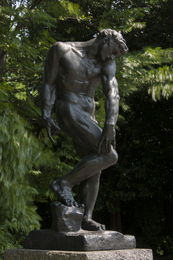Auguste Rodin
Paris, 1840 - Meudon, 1917
アダム Adam
| 制作年 | 1881年(原型) |
|---|---|
| 材質・技法・形状 | ブロンズ |
| 寸法(cm) | 198 x 76 x 84 |
| 署名・年記 | 台座右側面に署名: Rodin; 台座背面右に鋳造銘: Alexis. Rudier / fondeur. Paris |
| 所蔵経緯 | 松方コレクション |
| Standard ref. | M1249 |
| 分類 | 彫刻 |
| 所蔵番号 | S.1959-0001 |
1875年、イタリアに旅行したロダンは、ミケランジェロに大きな影響を受けて帰国した。帰国後間もなく、彼はミケランジェロの芸術を理解するために一体の《アダム》を制作したが、あまりにも直接的なミケランジェロ彫刻の模倣であったため満足せず、これを打ち壊してしまった。《地獄の門》の構想過程において、ロダンは門の両脇に巨像を立てる着想を得た。そしてその二つの像は、人類の祖であり人間の業苦の根源である原罪を犯したアダムとエヴァが最もふさわしかった。ロダンは制作にあたってカイユーという名の「鉄の顎をもつ男」と呼ばれた力技の芸人をモデルに使った。《地獄の門》の上に立つ《三つの影》は、《アダム》とそっくりの姿に見えるが上体は《アダム》ほど捩じまげられてはおらず、全体にやや穏やかである。《三つの影》は《アダム》の制作過程に生まれたのであろう。アダムの肉体と姿勢にはミケランジェロのフィレンツェ大聖堂の《ピエタ》のキリストから受けた影響がはっきりと現われている。また右手の指の表現は、システィーナ礼拝堂天井画の「アダムの創造」の神から生命を与えられるアダムの指を想起させる。1881年のサロンにこの石膏像が出品された時、これは《人類の創造》と呼ばれていた。(出典: 国立西洋美術館名作選. 東京, 国立西洋美術館, 2006. cat. no. 131)
来歴
松方幸次郎氏購入; 1944年フランス政府が接収; 1959年フランス政府より寄贈返還.
展覧会歴
- 1966
- ロダン展: 没後50年記念, 国立西洋美術館, 1966年7月23日-1966年9月11日, cat. no. 15
- 1989
- ロダン「地獄の門」展: 開館30周年記念展, 国立西洋美術館 , 1989年10月21日-1989年12月17日, cat. no. 4
文献歴
- 1989
- Goldscheider, Cécile. Rodin, vie et œuvre, Tome I. Paris, Wildenstein Institute, 1989, pp. 152-153, no. 114.
- 1990
- 神戸市立博物館編. 松方コレクション西洋美術総目録. 神戸, 「松方コレクション展」実行委員会, 1990, cat. no. S-15.
- 2006
- 国立西洋美術館名作選. 東京, 国立西洋美術館; 東京, 西洋美術振興財団, 2006, no. 131, repr.
- 2009
- Masterpieces of The National Museum of Western Art, Tokyo. Tokyo, The National Museum of Western Art; Tokyo, The Western Art Foundation, 2009, no. 131, repr.
- 2013
- 国立西洋美術館名作選. 東京, 西洋美術振興財団, 2013, no. 130, col. repr.
- 2019
- 松方コレクション:西洋美術全作品. 川口雅子; 陳岡めぐみ編. 第2巻 彫刻・素描・版画・工芸その他, 東京, 国立西洋美術館, 2019, cat. no. 1249, col. repr.
Adam
| Date | 1881 (model) |
|---|---|
| Materials and Techniques | bronze |
| Size(cm) | 198 x 76 x 84 |
| Inscriptions | Signed right side of base: Rodin; Foundry mark right back of base: Alexis. Rudier / fondeur. Paris |
| Credit Line | Matsukata Collection |
| Standard ref. | M1249 |
| Category | Sculptures |
| Collection Number | S.1959-0001 |
Rodin traveled to Italy in 1875, and returned to France having been greatly influenced by Michelangelo. Almost immediately after his return to France, Rodin created a figure of Adam to understand the art of Michelangelo. He was not satisfied with this work, however, as it was too exact a copy of Michelangelo's sculpture, and in the end he destroyed it. When he began formulating his ideas for The Gates of Hell, Rodin decided to place monumental figures on either side of the gates. He decided that Adam and Eve, the originators of mankind's Original Sin, were the most appropriate figures to place in these positions. Rodin used Caillou, a strong artist known as the "Iron Jawed Man," as the model for his depiction of Adam. One of The Three Shades who stand on top of The Gates of Hell has the same upper body as Adam, but is shown in a less twisted and deformed form, exhibiting an overall calm demeanor. The Three Shades were probably created in the process of creating Adam. The image of Christ in the Pièta by Michelangelo in the Florence Cathedral can be clearly seen as an influence on Adam's physique and form. Also, we can imagine Adam's fingers receiving life from God in The Creation of Adam in the Sistine Chapel ceiling frescos, in the expression of the fingers on Adam's right hand. When a plaster cast of this work was exhibited in the 1881 Salon, it was called The Creation of Mankind. (Source: Masterpieces of the National Museum of Western Art, Tokyo, 2009, cat. no. 131)
Provenance
Bought from Musée Rodin by Kojiro Matsukata, Kobe through Léonce Bénédite, 1919, as ‘Adam’ (Fr. 35,000) [see order records of bronze casting ‘Adam’ and several letters between Bénédite and Suzuki & Co., August 1919, in Archives of Musée Rodin, Paris; copy in NMWA curatorial files]; sequestered by French government, 1944; vested in French government under San Francisco Peace Treaty, 1952; transferred by French to Japanese government, 23 January 1959; entered into NMWA, April 1959.
Exhibition History
- 1966
- Rodin, National Museum of Western Art, Tokyo, 23 July 1966 - 11 September 1966, cat. no. 15
- 1989
- Rodin et la Porte de l’Enfer (Rodin and the Gates of Hell), National Museum of Western Art, Tokyo, 21 October 1989 - 17 December 1989, cat. no. 4
Bibliography
- 1989
- Goldscheider, Cécile. Rodin, vie et œuvre, Tome I. Paris, Wildenstein Institute, 1989, pp. 152-153, no. 114.
- 1990
- The Old Matsukata Collection. Kobe City Museum, ed. Kobe, "Matsukata Korekushon Ten" Jikkoiinkai, 1990, cat. no. S-15.
- 2006
- Masterpieces of The National Museum of Western Art, Tokyo. Tokyo, The National Museum of Western Art; Tokyo, The Western Art Foundation, 2006 (Japanese, preface in Japanese and English), no. 131, repr.
- 2009
- Masterpieces of The National Museum of Western Art, Tokyo. Tokyo, The National Museum of Western Art; Tokyo, The Western Art Foundation, 2009, no. 131, repr.
- 2013
- Masterpieces: The National Museum of Western Art, Tokyo. Tokyo, The Western Art Foundation, 2013 (Japanese, preface in Japanese and English), no. 130, col. repr.
- 2019
- The Matsukata Collection: Complete Catalogue of the European Art. Kawaguchi, Masako; Jingaoka, Megumi, eds. vol. 2: Sculpture, Drawings, Prints and Decorative Arts and Other Works, Tokyo, The National Museum of Western Art, Tokyo, 2019, cat. no. 1249, col. repr.












